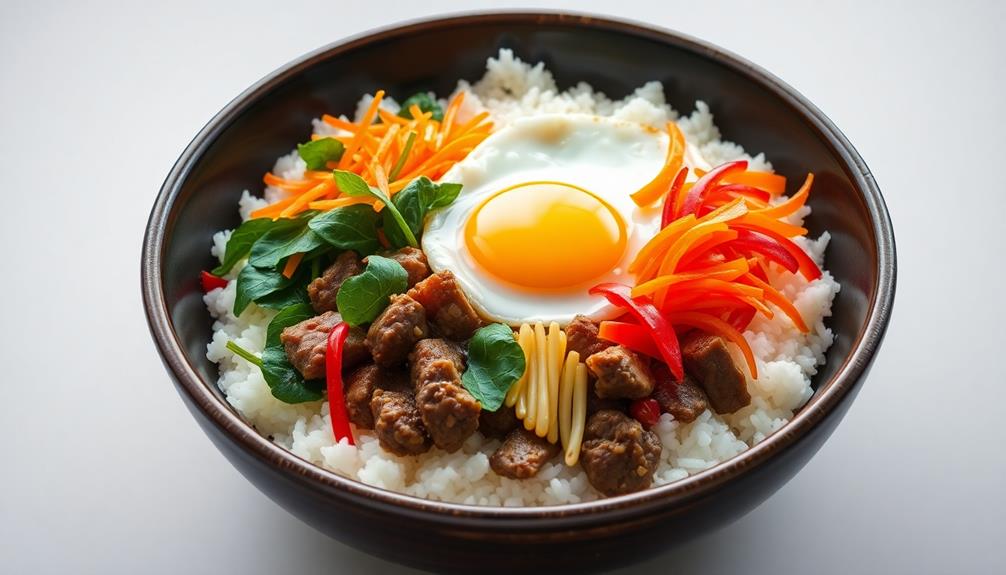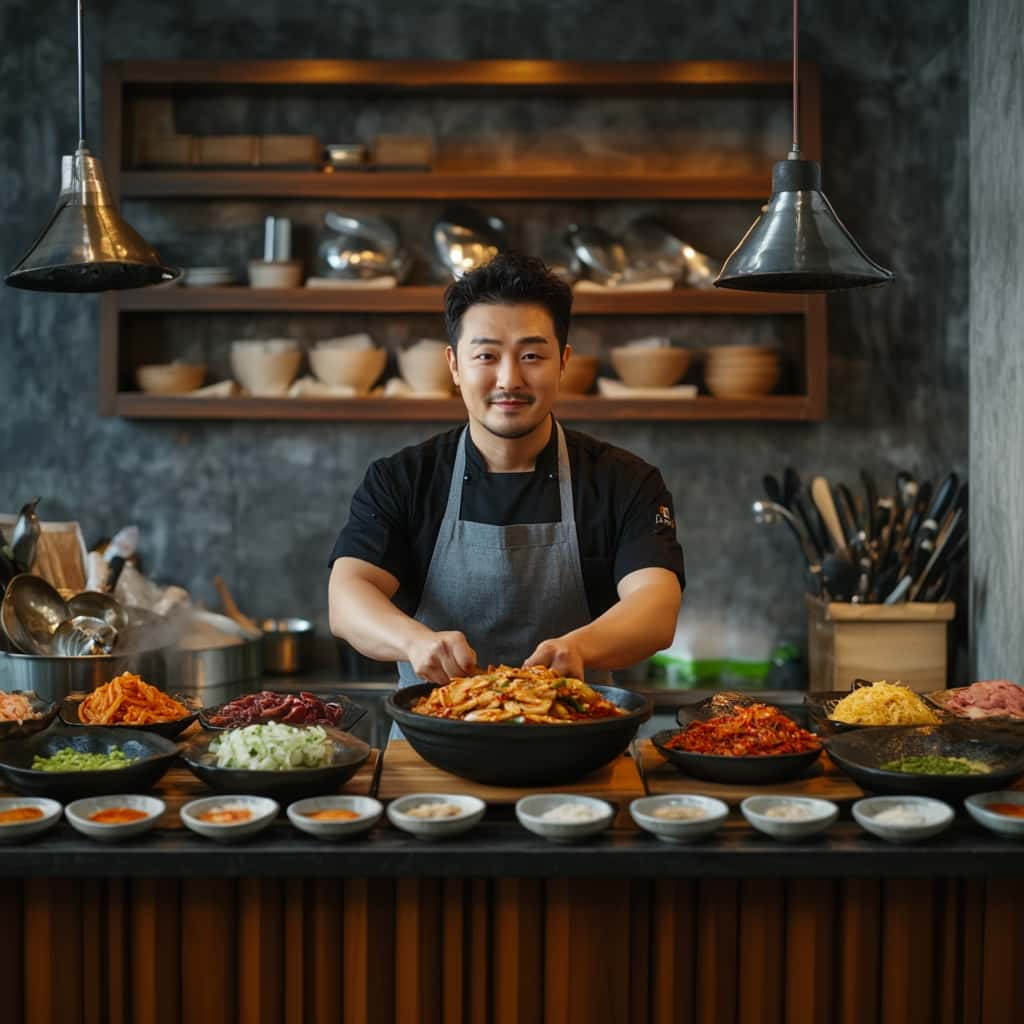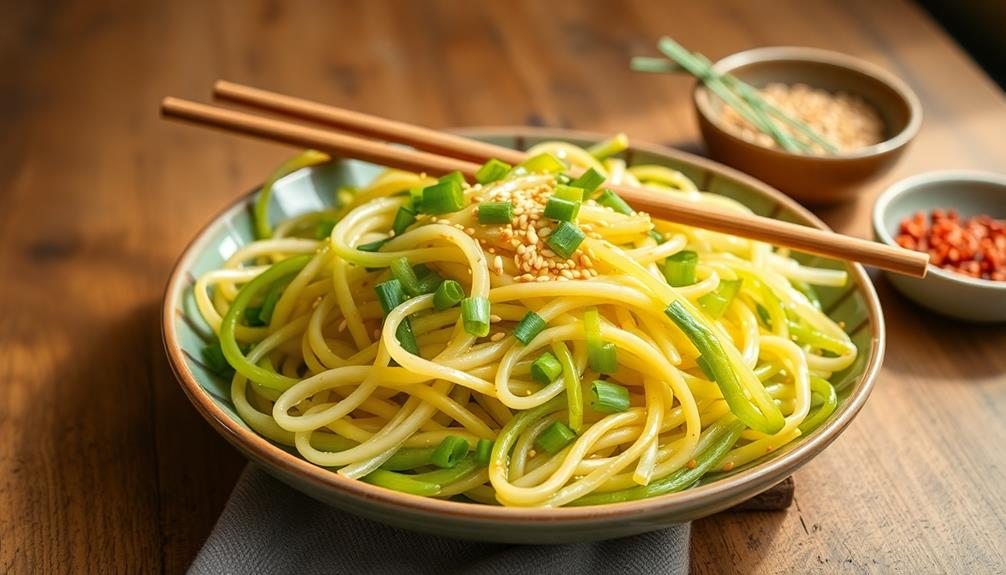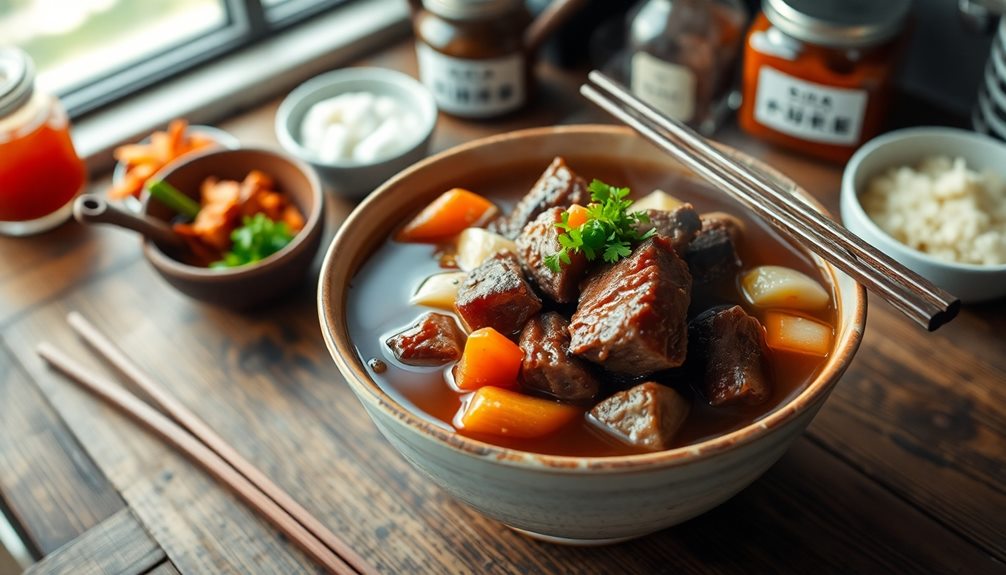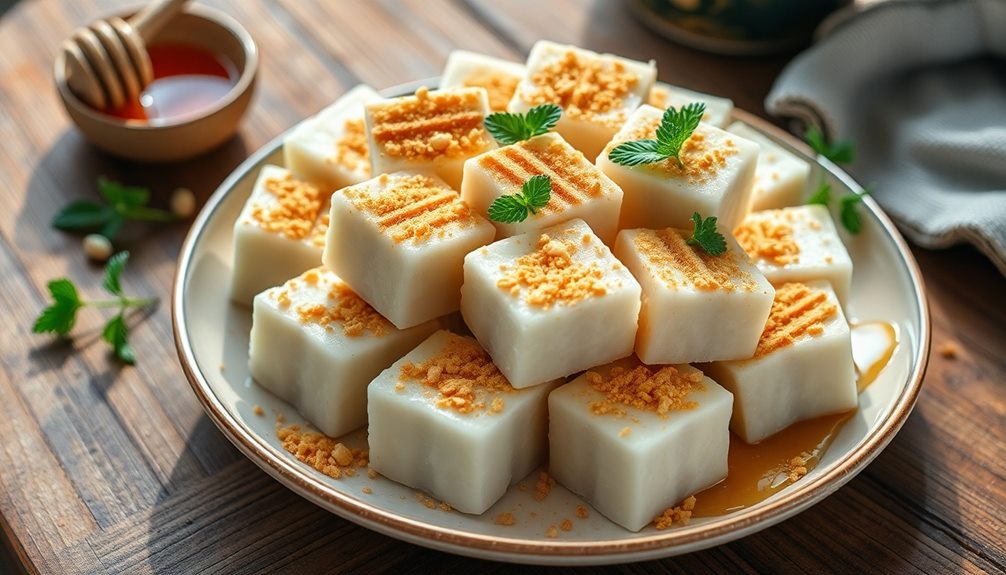Bibimbap is a vibrant and delicious Korean dish that'll have your taste buds dancing! It's a mixed rice bowl loaded with veggies, meat or tofu, a perfectly cooked egg, and a flavorful gochujang sauce. The origins trace back to the 19th century, and it's become a beloved national treasure. Mixing all the ingredients together creates a harmony of tastes and textures that's simply irresistible. You can even customize it to your dietary needs. Prepare to be amazed by the symphony of flavors in every bite! There's so much more to discover about this captivating Korean classic. If you want to bring the flavors of bibimbap into your own kitchen, you might also want to try a homemade kimbap recipe. Kimbap is similar to bibimbap in that it’s also a rice dish, but kimbap is a type of Korean sushi roll. Making kimbap at home is a fun way to experiment with different flavors and ingredients, and it’s a great way to experience the culinary traditions of Korea in your own home. So, why not explore the world of Korean cuisine and add a little bibimbap and kimbap to your recipe repertoire?
Key Takeaways
- Bibimbap is a traditional Korean mixed rice bowl, combining rice, vegetables, meat, and a fried or raw egg.
- The dish reflects the importance of balance in Korean cuisine and is often enjoyed during festive occasions.
- Bibimbap features a variety of sautéed vegetables, including carrots, spinach, mushrooms, and zucchini, along with a protein such as beef or tofu.
- The dish is typically served in a hot stone bowl (dolsot), and the gochujang (Korean chili paste) dressing adds a delightful kick.
- Bibimbap is high in vitamins and minerals, making it a nutritious and visually appealing meal that can be customized for various dietary preferences.
History
The origins of bibimbap can be traced back to traditional Korean cuisine, with its roots firmly planted in the country's rich culinary heritage. Long ago, farmers and laborers in Korea would mix together leftover rice, meat, vegetables, and sauces in a bowl, creating a nourishing and satisfying meal.
Over time, this simple dish evolved, and bibimbap became a beloved national treasure, showcasing the vibrant flavors and diverse ingredients that make Korean food so special.
Today, bibimbap is enjoyed worldwide, but it still holds a special place in the hearts and stomachs of Koreans. Whether you're dining in a cozy restaurant or whipping up a batch at home, the combination of warm rice, crunchy veggies, savory protein, and a tangy gochujang sauce is a true delight.
Recipe
Bibimbap is a beloved Korean dish that combines an array of vibrant flavors and textures. This one-bowl meal features a bed of warm rice topped with an assortment of sautéed and seasoned vegetables, a perfectly cooked egg, and a delightful gochujang (Korean chili paste) dressing.
The beauty of bibimbap lies in the harmonious blend of its components. Each ingredient contributes a unique flavor and texture, creating a symphony of sensations in every bite. The dish isn't only visually stunning but also deeply satisfying, making it a popular choice for both weeknight meals and special occasions.
Ingredients:
- 2 cups cooked short-grain white rice
- 1 pound ground beef or bulgogi (marinated beef)
- 1 carrot, julienned
- 1 cup spinach, blanched and squeezed dry
- 1 cup mushrooms, sliced
- 1 cucumber, julienned
- 2 scallions, thinly sliced
- 4 eggs
- 4 tablespoons gochujang (Korean chili paste)
- 2 tablespoons soy sauce
- 1 tablespoon sesame oil
- 1 teaspoon sugar
- Salt and pepper to taste
Instructions:
In a large skillet, cook the ground beef or bulgogi over medium-high heat until browned and cooked through. Transfer the meat to a bowl.
In the same skillet, sauté the carrot, spinach, and mushrooms separately until tender.
Arrange the cooked rice in four serving bowls and top with the sautéed vegetables, meat, cucumber, and scallions.
Fry the eggs sunny-side up or to your desired doneness. Place the fried eggs on top of the bowls.
In a small bowl, mix the gochujang, soy sauce, sesame oil, and sugar to create the dressing. Drizzle the dressing over the bibimbap and season with salt and pepper to taste.
Tip: For an extra touch of flavor, consider adding toasted sesame seeds or a sprinkle of Korean chili flakes (gochugaru) to the finished dish. The key to a delicious bibimbap is to ensure that each component is well-seasoned and cooked to perfection.
Cooking Steps
Cook up some tasty bibimbap by first cooking the rice to perfection.
Next, sauté the veggies in nutty sesame oil until they're nice and tender.
Then, add a fried egg on top and drizzle on that spicy gochujang sauce.
Step 1. Cook Rice
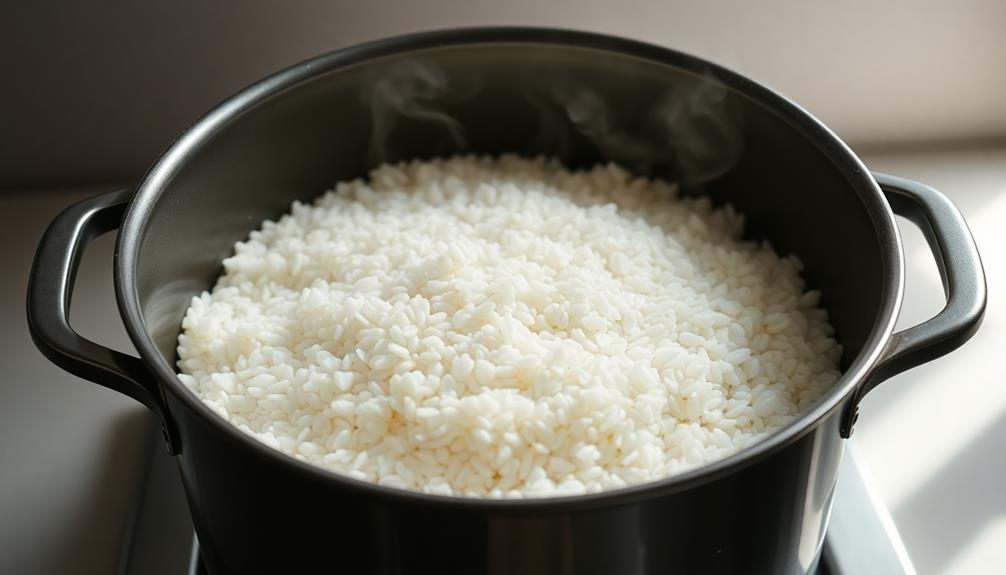
Begin by rinsing 1 cup of short-grain white rice under cold water until the water runs clear. This helps remove any excess starch, which can make the rice sticky and clumpy.
Next, transfer the rinsed rice to a medium saucepan and add 1 1/2 cups of water. Bring the mixture to a boil over high heat, then reduce the heat to low, cover the pan with a tight-fitting lid, and let the rice simmer for 15-20 minutes.
Don't peek! You want to keep all that steam inside to cook the rice perfectly.
Once the time's up, remove the pan from the heat and let it sit, still covered, for 5 more minutes. This allows the rice to finish steaming and become extra fluffy.
Fluff the rice with a fork, then you're ready to assemble your delicious bibimbap!
Step 2. Sauté Vegetables in Sesame Oil
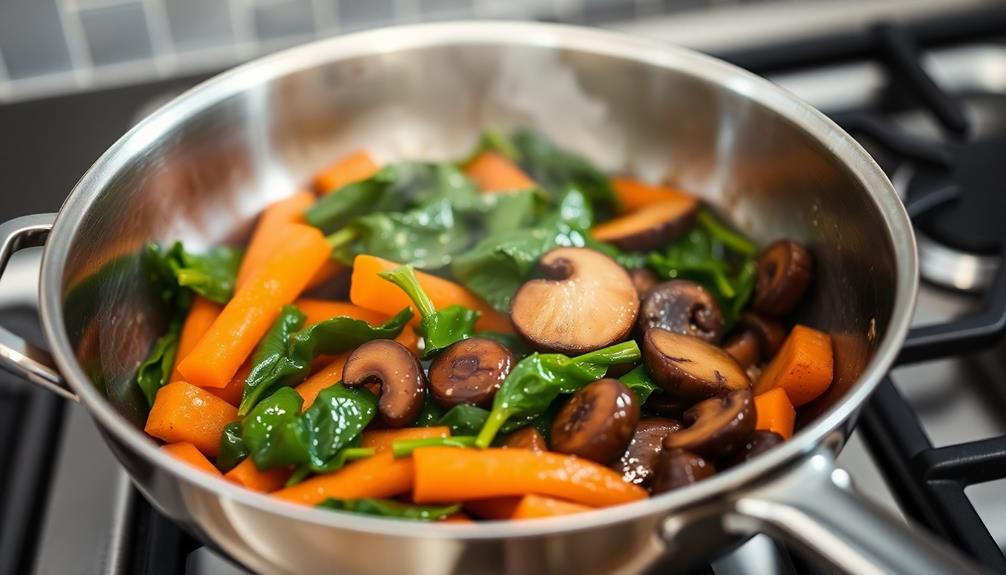
With the fluffy, perfectly cooked rice ready, you can now turn your attention to sautéing the vegetables.
You'll want to use a large skillet or wok and heat it over medium-high heat. Once the pan is hot, add a drizzle of sesame oil. The nutty aroma will fill the air, getting your taste buds excited!
Next, add your sliced or chopped vegetables. Carrots, spinach, mushrooms, and bean sprouts are all classic bibimbap ingredients.
Stir-fry the veggies, letting them sizzle and brown around the edges. Be sure to keep them moving so they don't burn. After a few minutes, they should be crisp-tender and full of flavor.
Step 3. Add Fried Egg

Next, you'll want to add a fried egg to your bibimbap. This is the perfect finishing touch to your colorful and delicious rice bowl!
Crack an egg into a hot, lightly oiled pan and let it sizzle for a minute or two. You'll know it's ready when the whites are set, but the yolk is still nice and runny.
Gently slide the fried egg right on top of your bibimbap. The warm, golden yolk will blend beautifully with the other ingredients, creating a mouthwatering combination of flavors and textures.
The runny yolk will also help coat the rice, making every bite extra creamy and rich.
Don't be afraid to add a little more sesame oil or soy sauce on top – the fried egg loves to soak up those savory seasonings.
Give the whole bowl a quick stir to incorporate everything. Now you've got a perfectly balanced and utterly scrumptious bibimbap, ready to enjoy!
Step 4. Add Gochujang Sauce

The fried egg is a superb finishing touch, but the true star of bibimbap is the gochujang sauce. This spicy Korean condiment is the flavor powerhouse that brings the whole dish together. It's made from gochujang (a fermented red chili paste), soy sauce, rice vinegar, and a touch of honey or sugar.
To make the sauce, simply combine all the ingredients in a small bowl and whisk until well blended. The sweet-savory-spicy flavor is simply irresistible!
Drizzle the gochujang sauce generously over the top of your bibimbap, making sure to get a bit in every bite. The sauce complements the various textures and flavors of the rice, vegetables, and meat so well. Its vibrant red color also makes the dish look extra appetizing.
Don't be shy – add as much or as little as you like to suit your spice preference. The gochujang sauce is what truly makes bibimbap shine, so be sure to give it the spotlight it deserves!
Step 5. Mix Everything Together
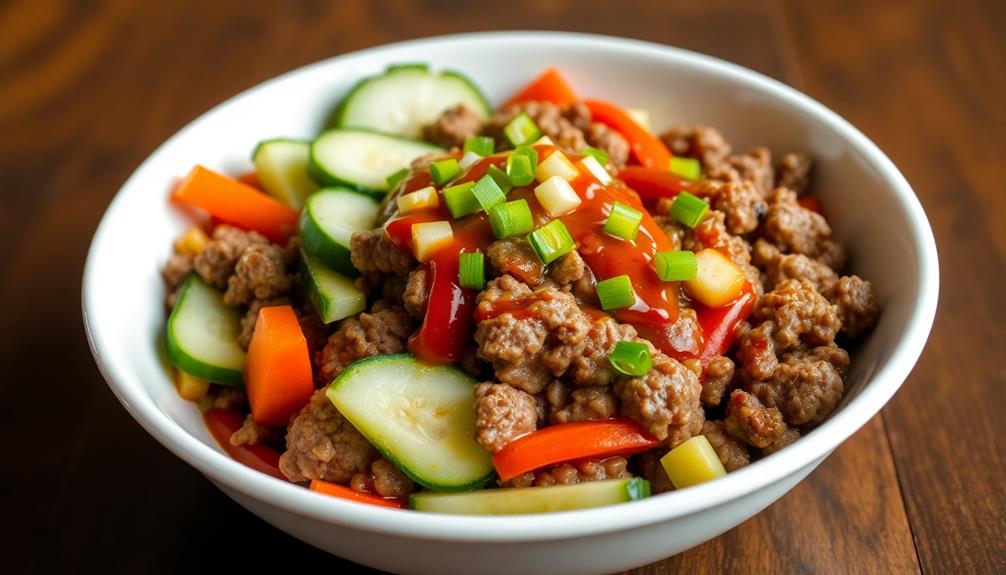
Once you've assembled all the components, it's time to bring the dish together. Grab your bowl and start layering the ingredients. First, add a bed of warm, fluffy rice to the bottom. Next, arrange your colorful vegetables on top – crisp carrots, vibrant spinach, and tangy bean sprouts. Don't forget the savory beef and the perfect sunny-side-up egg!
Now, it's time to get your hands dirty. Using your chopsticks or a spoon, gently mix everything together, making sure all the flavors mingle. Drizzle that delicious gochujang sauce all over, adding a kick of spicy-sweet goodness.
Keep mixing and tossing until the rice is evenly coated and the vegetables are well-incorporated. The final step is to dig in and enjoy your masterpiece!
The combination of textures and flavors is truly divine. With each bite, you'll experience a symphony of tastes that'll have your taste buds doing a happy dance. Savor every mouthful and let the flavors of Korea dance on your tongue.
Final Thoughts
Bibimbap is a delightful Korean dish that has captured the hearts and palates of food enthusiasts worldwide. It's a vibrant and satisfying meal that allows you to explore the depth of flavors and textures that Korean cuisine has to offer. From the fluffy rice base to the colorful array of vegetables, each component plays a vital role in creating the perfect balance of taste and nutrition.
Once you've assembled your bibimbap and mixed everything together, it's time to sit back, relax, and enjoy the fruits of your labor. Take a moment to appreciate the hard work and care that went into preparing this dish.
Whether you're sharing it with friends or savoring it solo, bibimbap is sure to bring a smile to your face and warmth to your heart. So, dig in, explore the layers of flavors, and let the vibrant colors and satisfying textures transport you to the heart of Korean culinary delights.
Frequently Asked Questions
Is Bibimbap Considered a Traditional Korean Dish?
Yes, bibimbap is considered a traditional Korean dish. It's a staple in Korean cuisine, featuring a delicious mix of rice, vegetables, and sometimes meat, all combined in a bowl for a flavorful and nourishing meal.
How Long Does It Take to Prepare Bibimbap?
Preparing bibimbap typically takes 30-45 minutes, depending on your familiarity with the dish. You'll need to cook the rice, prepare the various vegetable toppings, and assemble everything in a bowl. It's a relatively quick and easy Korean meal to make at home.
Can Vegetarians Enjoy Bibimbap?
Absolutely! Vegetarians can absolutely enjoy bibimbap. The dish's versatility allows you to customize it with your favorite veggies, tofu, or other meat-free toppings, making it a delicious and satisfying option for vegetarian diners.
Is There a Specific Type of Rice Used in Bibimbap?
Yes, there's a specific type of rice used in bibimbap. It's typically short-grain white rice, which helps the dish have a sticky, cohesive texture that's perfect for mixing all the delicious ingredients together.
Can Bibimbap Be Served Cold or Must It Be Hot?
Bibimbap can be served either hot or cold, depending on your preference. The dish is versatile, allowing you to enjoy it at different temperatures to suit your taste and mood.
